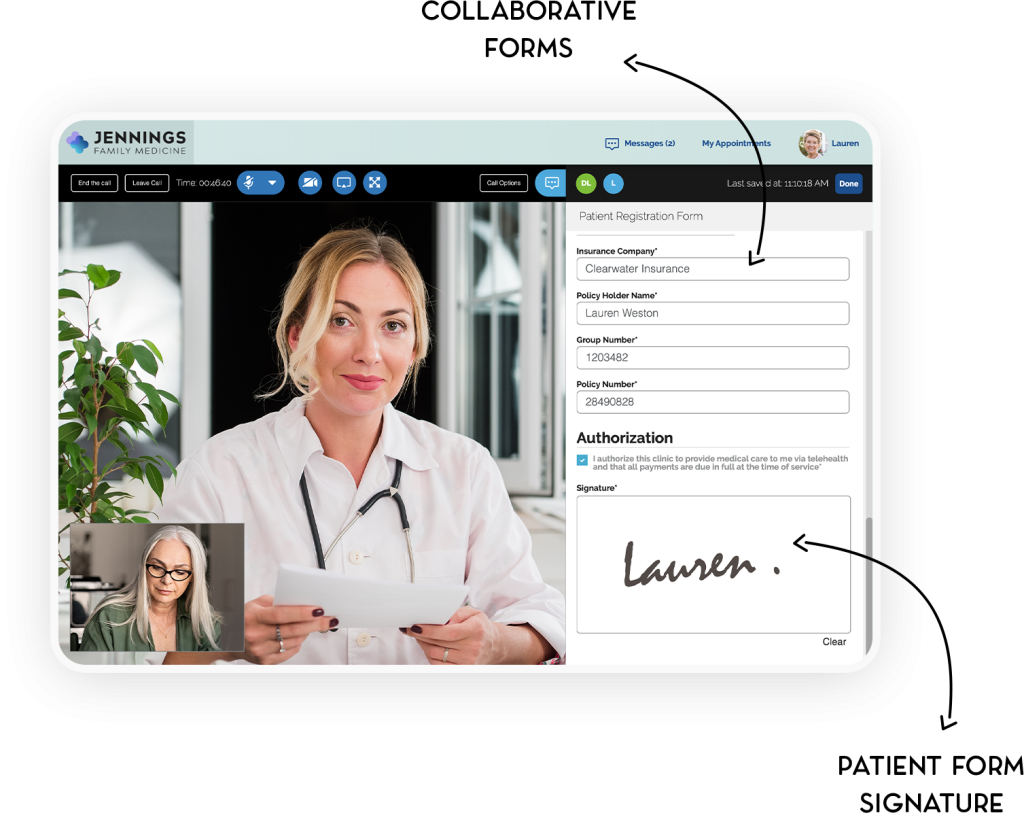How has the role of WebRTC in healthcare changed in recent years? It has been a few years (and a pandemic) since our team at WebRTC.ventures has been able to attend a HIMSS conference on healthcare IT. Our CEO and Founder Arin Sime headed out to the HIMSS 2023 conference in Chicago to see the latest advances.
In the video below, Arin talks about different companies that he met, and the ways that WebRTC video is being used in healthcare in 2023. Many WebRTC applications are combining video and audio communications in the browser with AI and ML capabilities for detection of objects in the video, health analysis of patients, conversational AI, and more.
You’ll see a demo of Anura, an application that detects basic health metrics purely from a video which is captured over WebRTC (full product pending FDA approval). Arin also spends time at the Amazon Alexa Smart Properties booth, seeing a demo of how WebRTC can be used in Alexa Skills now and how Alexa devices are being used in healthcare.
The blog post below the video expands on all of this, so join us for a virtual visit to the exhibit hall at HIMSS 2023. After that contact our team at WebRTC.ventures for a quote on integrating video into your healthcare application!
My last (attempted) visit to HIMSS
In March 2020, I was supposed to attend a HIMSS conference in Orlando. Our team was busily preparing to exhibit our telehealth starter kit, SimplyDoc (which I talk more about in the video above and you can see a demo of SimplyDoc near the end of the video). We had purchased airfare, and I was preparing to drive our exhibit booth materials to Florida because I didn’t feel like paying for the shipping.
Then the world changed, seemingly overnight. We canceled our trip to HIMSS even before the conference itself was canceled. One member of our team still wanted to visit Disney. She was one of the last people in the park before it was closed for months. My wife Lauren and I had just been traveling internationally the week before, and she became very ill.
There was no COVID testing at the time. Using only the original telehealth tool: the phone, Lauren’s doctor suggested she just stay home. There was no point in going to the hospital unless she got worse, as they couldn’t treat mild cases effectively at the time. Thankfully, she felt better after a couple of weeks with no long-term effects. Later antibody testing suggested she probably did not have COVID at that time. It was a rough start to the pandemic for our business and family, but we were still fortunate compared to many.
Our experiences in the pandemic only further cemented our belief in the value of Telehealth. That has certainly been true across the industry, where the usefulness of Telehealth is no longer debated for many use cases.
WebRTC.ventures’ experience in Telehealth
Our team has been building telehealth applications since 2015. We were already well acquainted with the space prior to the pandemic. Our first application for a client was a telemental health solution for use in Australia. Over the next few years, we continued to build a variety of health and wellness applications which incorporated WebRTC video for a variety of use cases. It was common for us and our clients to need to convince healthcare professionals that secure telehealth was possible and worth investing in!
Still, we built so many telehealth apps that we were able to identify trends in what clients wanted: secure video, audio, text chat, dial-in capabilities, screen sharing, and more. So, we built a starter kit of code which could be easily white labeled and customized and named it SimplyDoc.
SimplyDoc includes 80% of the features most telehealth applications need. Some clients license and customize the SimplyDoc code base in order to speed up implementation of a telehealth application. Others choose a completely custom telehealth solution.

In short, we’ve done a lot with Telehealth here at WebRTC.ventures. But as I’ve often said, good telehealth is about more than just having good video.
Telehealth has advanced with the help of AI
Although life has returned to something resembling normal for most people, the pandemic brought permanent changes in many areas — both good and bad. Healthcare is no exception.
At HIMSS 2023, it was clear that no one needs to sell the value of Telehealth any longer. The solutions being exhibited at the conference were also much more sophisticated than prior to the pandemic.
The most striking observation about the use of video and WebRTC in the HIMSS exhibit hall was how many vendors are demonstrating video applications that also incorporate AI and Machine Learning (ML). I saw a demo of an application which analyzes video in real-time to determine if the patient has fallen out of their bed. Another determined whether healthcare professionals are washing their hands as frequently as required. And so many other use cases where AI and ML were game changers.
As a specific example, one interesting demo I saw was by Anura, whose browser-based application uses WebRTC to capture a 30 second video of a person’s face. The video is fed into an ML algorithm which detects information about the blood vessels in the face, so good lighting is a must. The algorithm uses this information to estimate health indicators such as blood pressure, heart rate and variability, likelihood of cholesterol problems and future stroke risk, and more. If you watch my video from the HIMSS conference, you’ll see a demo and the results it generated for me.
The application is still pending FDA approval to use all the measurements demonstrated. Anura expects to sell this to healthcare facilities, insurance companies, or others as a white labeled solution. Using WebRTC, it could even be embedded directly in a company’s website. I could imagine this as part of a life insurance application to cross check the health information the applicant enters in their forms, as just one example of its usefulness.
Voice and Conversational AI in Healthcare
This was a fascinating example of using WebRTC and AI together in healthcare, and Conversational AI is also continuing to grow in use. To see this, I visited the Alexa Smart Properties booth, where Amazon’s popular smart home devices were demonstrated for use in hospital settings.
Patients can use Alexa for bedside care, as a way to call medical staff, perhaps control devices in their room, or even to stay in touch with family members who are not at the hospital. Outside of the hospital, Alexa devices can be used in many other healthcare scenarios such as senior care facilities.
Using WebRTC on Amazon Alexa devices
While most Alexa devices are audio only, I’ve been intrigued by the use of video with Alexa ever since the Echo Show was first launched in 2014. I purchased a couple and we experimented with building Skills for them which would bring up recorded videos for use cases such as sports highlights. However, the video calls were only possible using a proprietary calling format between Alexa Show devices.
I hoped that WebRTC support would someday be added into Alexa so that we could incorporate more open video standards into an Echo Show device and interface with other business processes. Imagine customers calling your customer contact center directly from their Alexa device, or even having a video chat if they are on a video enabled device such as Alexa Show. That dream is now finally coming to fruition with the addition of WebRTC capabilities to Alexa skills. At the Alexa Smart Properties booth, I saw a demo of this capability.
Our team at WebRTC.ventures are System Integration Partners for the Amazon Chime SDK and are already building WebRTC based video applications using the Amazon Chime SDK. Now, we can incorporate that same SDK directly into an Alexa Skill. Other media servers and CPaaS’s can be used as well. Any WebRTC connection will do!
This functionality is in Beta as of April 2023. Hopefully a general release will happen in a few months. I’m really looking forward to applying our WebRTC experience to Alexa Skills. Do you have an Alexa Skill that you would like to add WebRTC based audio or video calls into? Contact us now and we can begin the development even before the general release is available!
Building Apps Around Video Experiences
The WebRTC standard has matured. It is now used in many situations across healthcare and other industries. It’s been incorporated into so many different CPaaS solutions and open-source media servers that it can be hard to decide how to build your application! Fortunately, our team has a wide range of experience and we can help you choose the best platform for your specific needs.
The last time I attended a HIMSS conference in 2018, the use of WebRTC video in healthcare was a novelty. That is no longer the case. Now, companies need to go beyond simply integrating the simplest or cheapest video API into an application and calling it telehealth. To build truly valuable video applications, and to integrate them with intelligent services for AI and ML, you need a team of experts who have been there before. Thankfully, you found them – it’s us!
Our team is here to help, whether you need a full custom build, an assessment to improve your current solution, or the integration of secure video into your existing workflows, we have done it before. We’ve worked with some of the biggest names in SaaS telehealth applications as well as with brand new startups, and we can apply our video design and development expertise to your unique needs. Contact us today for more information!












